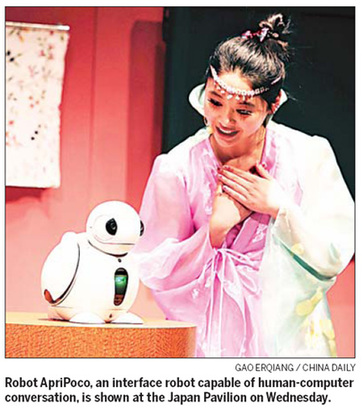State-of-the-art machines can provide support for home, work
SHANGHAI - Not all artificial intelligence, it seems, will end up like The Terminator or The Matrix.

Japan, the world's leading robot innovator, demonstrates in its pavilion at the Expo how humans and robots can coexist safely and harmoniously, with its series of "human support robots".
The robot family presented by Japan New Energy and Industrial Technology Development Organization (NEDO) includes humanoid robot HRP-2, interface robot ApriPoco, cleaning robot, porter robot, and two mobility-assisting robot suits.
|
Full Coverage:
 | | |
Visitors to the Japan Pavilion can get hands-on experience of these cutting-edge technologies.
"It feels like my strength has doubled," said Yao Chen, a 23-year-old college student, when she tried on the Honda stride management assist device. "My legs have become lighter and movements are easier. I think this will be perfect for going hiking."
But hikers will have to wait, because the device, which can be worn on the crotch to generate extra dynamic movements, was originally developed to provide assistance to those with walking disabilities, as was the Cyberdyne full body robot suit HAL.
Other robots such as the cleaner and porter have also been created to free humans of heavy labor work.
"Some of these robots are already in practical use in Japan," said Takahiko Miyao, representative of NEDO in Beijing. "For instance, one cleaning robot can clean every floor of an entire office building when employees are off work, for it knows how to use the elevator," he said.
The real star of the show, however, is ApriPoco, who, with its charmingly nave figure, is a hit among the women. As an interface robot, it is capable of human-computer conversation and executing orders such as "turn on the TV" or "turn off the light".
"ApriPoco is like a child who is curious about everything," said Yoshiko Yurugi from NEDO. "Although now it can speak only two languages (Japanese and Chinese), and understands very simple commands, it will go on getting smarter through interactions with humans," she said.
A show featuring these technologies is being staged at the event building beside the Japan Pavilion from May 19 to 23. The show starts at 10:30 am with 10 consecutive shows every day.
These technologies were developed with an aim to deal with an aging society. And the exhibition at the Expo was to further the possibility of robots with visitors from around the world, the exhibitors said.
However, not everyone is positive about the future of these highly valued human replacements.
"I doubt if these robots will have practical use in China, as hiring a nanny or a hamaul is much cheaper than purchasing a cleaning robot or a porter robot," said 26-year-old Song Kang.
Some of these technologies are still in under experiments and the price has not yet been fixed. But Song is sure they won't come cheap.
"These technologies are indeed a little expensive for everyone to afford," said Yoshiko from NEDO. "But I hope the government will pay for a certain amount for the application of these technologies for the benefit of society."
CHINA DAILY

